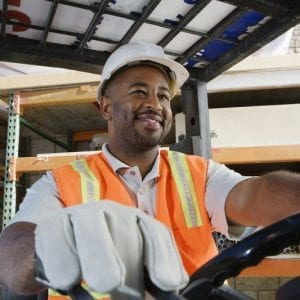
Powered industrial trucks—forklifts—are commonplace in manufacturing and warehousing facilities. They are crucial to ensure the safe material transport of goods. They can also be deadly. Reported statics place the number of forklift-related accidents at close to 100,000 per year (100 fatal accidents, 34,900 serious injury accidents, and 61,800 non-serious accidents). More than 40% of fatalities are due to the forklift rolling or toppling on top of the operator or other worker. Individuals who handle heavy material handling equipment such as forklifts need to take special precautions to ensure that the materials they transport are properly handled. The safest place for a driver to be is strapped into a seat with a seat belt. Hazards associated with operation include mounting and dismounting (risk of head injury, slips, trips, and falls); starting and stopping; operating at speeds (risk of tipovers and collisions with pedestrians or objects); steering, turning, and changing direction (risk of tipovers and collisions with pedestrians or objects); reversing (risk of risk of tipovers and collisions with pedestrians or objects); travelling on inclines (risk of tipovers and falling loads); parking (risks of collisions or unintended movement). Load handling presents an additional set of hazards to operators. Off-center loads, overloading, and damaged or loose loads can all cause tipover or falling loads and collisions if the driver’s view is impaired. Moving loads onto truck trailers or railroad cars can cause falling and tipover hazards, as well as potential hazards to other workers. Forklifts can be especially dangerous for pedestrians . UL’s EHS expert Jonathan Jacobi recently took a look at the tension between forklifts and pedestrians in a recent podcast. Listen to it here . OSHA’s website contains several sections dedicated to the dangers associated with forklifts. If you work with or around powered industrial truck, make sure you’re informed […]



Leave a Reply
You must be logged in to post a comment.